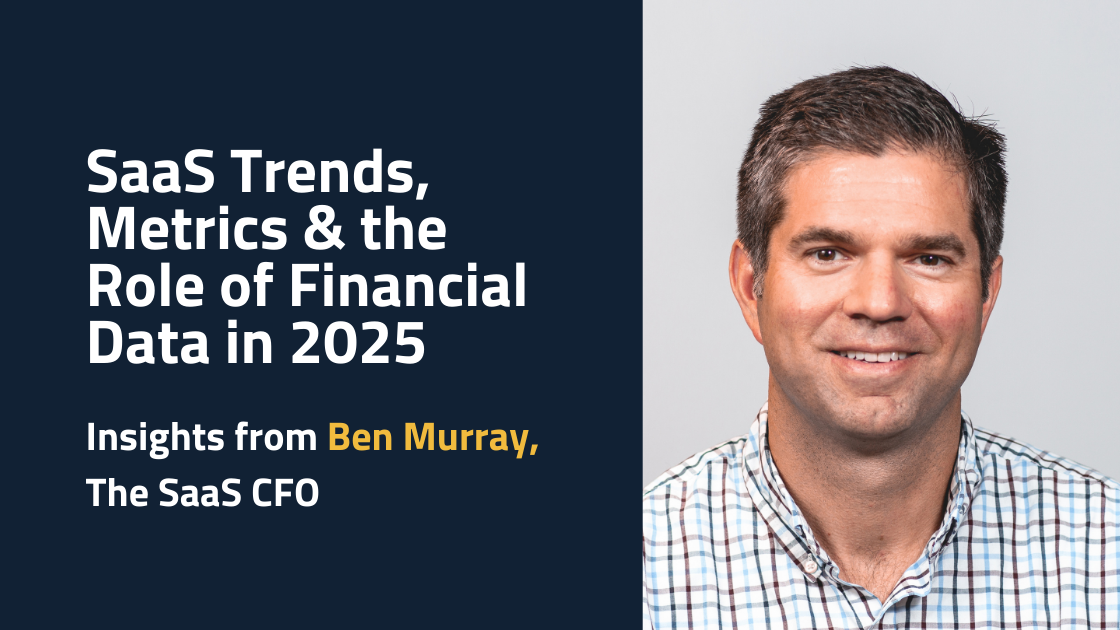Insights from Ben Murray: SaaS Trends, Metrics, and the Role of Financial Data in 2025
Discover key SaaS trends, metrics, and strategies for 2025 with insights from Ben Murray, The SaaS CFO. Learn how financial data, AI, and revenue diversification drive growth and profitability.

Jump to read
The Critical Role of Financial Data in SaaS
Five Key SaaS Metrics for SaaS Success in 2025
Emerging Trends: AI and Revenue Diversification
Balancing Growth and Profitability
Preparing for the Future with the Right Tools
As we move toward 2025, interest rates, the cost of capital, and budgets may be gradually shifting toward a more positive outlook. However, market dynamics remain unpredictable, making caution essential.
The strategy for the year ahead should focus on striking the right balance between growth, operational efficiency, and financial sustainability, with AI-driven innovation, and precise financial metrics, as drivers.
Properly understanding your metrics and data will provide a solid foundation for finance leaders, enabling them to effectively manage all financial aspects of the business, regardless of the challenges ahead.
In our latest webinar, we covered this exact topic with Ben Murray, The SaaS CFO— exploring key SaaS trends, metrics, and the role of financial data in shaping the industry in 2025. From hybrid growth models to AI's impact on financial operations, Ben shared actionable insights for SaaS leaders preparing for the future. Here are the key takeaways from our discussion:
The Critical Role of Financial Data in SaaS
Gone are the days when gut feelings or isolated data points were sufficient. Real-time financial data has become the backbone of strategic decision-making in SaaS, enabling companies to monitor their health and chart a clear course for growth. "We, as CFOs, have to be the data stewards of the organization,” Ben shared. “There’s so much tech going on behind the scenes to run our SaaS companies, but it’s still true today that we have to unlock that data and leverage it effectively.”
For SaaS CFOs, the ability to access real-time insights from the SaaS P&L (Profit & Loss statement) is critical. The P&L should not just be an end-of-month report, but a dynamic resource used across departments. From gross margins by revenue streams to OpEx profiles and EBITDA, these metrics empower leadership teams to make informed decisions at speed.
Five Key SaaS Metrics for SaaS Success in 2025
Tracking the right metrics is essential for achieving sustainable growth. According to Ben, the following metrics will be particularly crucial as we move forward:- Annual Recurring Revenue (ARR): ARR is vital for forecasting growth and ensuring consistent revenue streams. It helps SaaS businesses predict future performance and set strategic growth goals.
- Net Revenue Retention (NRR): Retaining customers is just as vital as acquiring them. Ben highlighted retention as a key driver of sustainability: “We need to know where growth is coming from—new customers or existing ones—and ensure our retention rates, both gross and net, are strong.”
- Gross Margins: With increased pressure to scale efficiently, gross margins help SaaS businesses maintain financial health. He emphasized, “If you’re not managing gross margins, your ability to grow and scale becomes limited.”
- Customer Acquisition Cost (CAC) vs. Lifetime Value (LTV): The balance between acquisition cost and customer value is critical to ensure long-term profitability. Understanding and optimizing the CAC/LTV ratio ensures efficient spending and long-term customer profitability.
- Days Sales Outstanding (DSO): DSO measures how long it takes to collect payments. Effective management of DSO is key for maintaining liquidity and ensuring positive cash flow.
Beyond these metrics, the SaaS landscape is also being shaped by other major trends that will influence how these metrics are managed and optimized.
Emerging Trends: AI and Revenue Diversification
Looking ahead, SaaS companies must prepare for the impact of AI and hybrid growth models on their financial strategies. AI-first solutions are already transforming key areas like usage-based pricing and predictive forecasting. As Ben noted, "With AI, we now have to think beyond traditional costs—compute power, token usage, and scalability all come into play.”
With SaaS companies now managing a mix of subscription, usage-based, and outcome-based revenue streams, strong systems are required to track and optimize performance, driving the need for revenue diversification. Ben highlighted how this shift has made financial operations more complex, with CFOs needing to ensure clean data and accurate metric calculations.
Balancing Growth and Profitability
Scaling a SaaS business is one thing; scaling profitably is another. Ben stressed the importance of setting clear financial goals: "Do you want to grow at all costs, or is sustainability your priority? That perspective dictates where to focus financially."
Achieving this balance requires strong fundamentals, including accurate accounting practices and clean financial data. SaaS companies must also prepare for a more nuanced future by aligning their financial structures with go-to-market strategies like product-led growth (PLG) or sales-led growth (SLG).
Preparing for the Future with the Right Tools
As we approach 2025, it’s clear that the role of financial data in SaaS cannot be overstated. The companies that succeed will be those that can leverage real-time insights to make smarter, faster decisions. For SaaS CFOs and founders, this means prioritizing the right metrics, embracing new technologies, and ensuring that financial data drives strategic planning.
To put these principles into action, SaaS leaders need the right tools to support real-time financial insights and automated operations. A subscription management solution, like Younium, plays a crucial role in this journey. Acting as a single source of truth, Younium empowers SaaS leaders with real-time insights into key financial metrics like ARR, NRR, and churn while automating subscription billing and invoicing. With features designed to handle complex pricing models and streamline operations, Younium enables businesses to focus on strategy and growth rather than administrative tasks.
Discover how Younium’s Next-Generation Insights can provide clarity and real-time KPIs to simplify financial operations and scale confidently.
Stay updated by following us on LinkedIn.